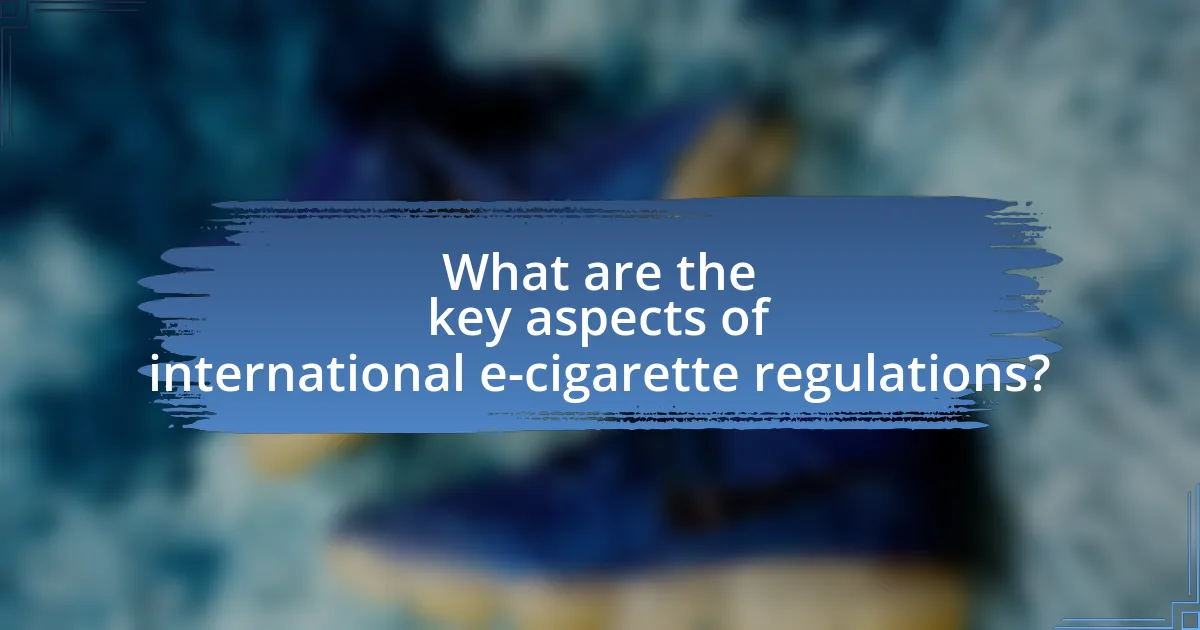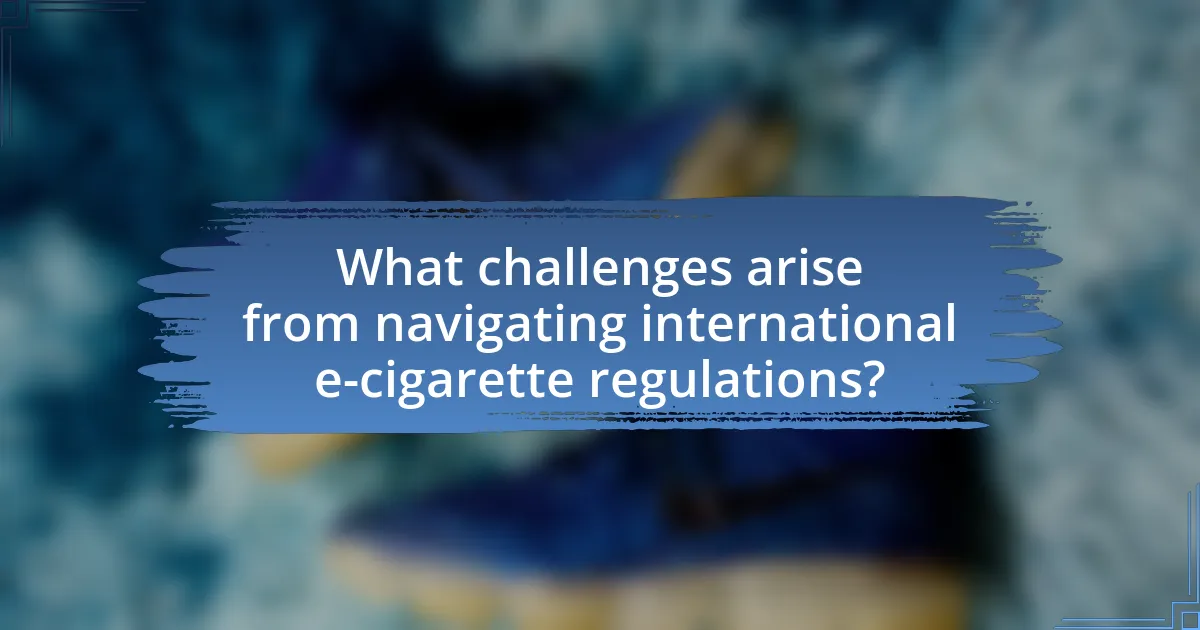The article focuses on the complexities of international e-cigarette regulations, highlighting key aspects such as age restrictions, product safety standards, advertising limitations, and taxation policies. It examines how different countries approach these regulations, with specific attention to the regulatory frameworks in the United States and the European Union, as well as unique regulations in various Asian countries. The article also discusses the implications of these regulations for public health, manufacturers, and retailers, while addressing common compliance issues and the challenges businesses face in navigating diverse legal landscapes. Additionally, it outlines best practices for ensuring compliance and resources available for understanding regulatory requirements.

What are the key aspects of international e-cigarette regulations?
The key aspects of international e-cigarette regulations include age restrictions, product safety standards, advertising limitations, and taxation policies. Age restrictions typically mandate that e-cigarette purchases are limited to individuals above a certain age, often 18 or 21, to prevent youth access. Product safety standards require manufacturers to comply with specific health and safety guidelines, ensuring that e-cigarettes do not contain harmful substances and are manufactured under safe conditions. Advertising limitations often restrict marketing practices to minimize appeal to minors and prevent misleading claims about health benefits. Taxation policies vary significantly across countries, with some imposing high taxes on e-cigarettes to discourage use, while others may offer lower rates to promote harm reduction. These regulations are influenced by public health concerns and the need to balance consumer choice with safety.
How do different countries approach e-cigarette regulations?
Different countries approach e-cigarette regulations with varying degrees of restriction and oversight. For instance, the United States allows e-cigarettes to be sold with minimal regulation, focusing primarily on age restrictions and labeling requirements, while the European Union enforces stricter regulations under the Tobacco Products Directive, which includes limits on nicotine content and advertising. In contrast, countries like Australia classify e-cigarettes containing nicotine as prescription-only products, significantly limiting their availability. These regulatory differences reflect diverse public health strategies and cultural attitudes towards smoking and vaping, impacting market dynamics and consumer access globally.
What are the regulatory frameworks in the United States?
The regulatory frameworks in the United States encompass a variety of laws and agencies that govern different sectors, including health, safety, and commerce. Key regulatory bodies include the Food and Drug Administration (FDA), which oversees the regulation of tobacco products, including e-cigarettes, under the Family Smoking Prevention and Tobacco Control Act. Additionally, the Federal Trade Commission (FTC) regulates advertising practices, while state and local governments may impose their own regulations on the sale and use of e-cigarettes. These frameworks are designed to protect public health and ensure consumer safety, reflecting the complexities of managing emerging products like e-cigarettes within existing legal structures.
How does the European Union regulate e-cigarettes?
The European Union regulates e-cigarettes primarily through the Tobacco Products Directive (TPD), which was implemented in May 2016. This directive establishes specific requirements for the manufacture, presentation, and sale of e-cigarettes and refill containers. Key regulations include a maximum nicotine concentration of 20 mg/ml, child-resistant packaging, and health warnings on packaging. Additionally, manufacturers must submit product notifications to national authorities before marketing their products, ensuring compliance with safety and quality standards. The TPD aims to protect public health while allowing adult smokers access to less harmful alternatives.
What unique regulations exist in Asian countries?
Asian countries have unique regulations regarding e-cigarettes that vary significantly across the region. For instance, in Japan, e-cigarettes containing nicotine are regulated under the Pharmaceutical and Medical Device Act, requiring manufacturers to obtain approval before selling their products. In contrast, countries like Thailand have implemented strict bans on e-cigarettes, with penalties including fines and imprisonment for possession. Additionally, Singapore enforces a complete prohibition on the sale, import, and distribution of e-cigarettes, reflecting a stringent public health policy. These regulations highlight the diverse approaches Asian countries take towards e-cigarettes, influenced by cultural, health, and legal considerations.
Why is it important to understand these regulations?
Understanding international e-cigarette regulations is crucial for compliance and market access. These regulations dictate the legal framework within which e-cigarette products can be manufactured, marketed, and sold in different countries. Non-compliance can lead to significant legal penalties, including fines and product seizures, as evidenced by the European Union’s Tobacco Products Directive, which imposes strict guidelines on e-cigarette sales. Additionally, understanding these regulations helps businesses navigate varying standards, ensuring product safety and consumer protection, which are essential for maintaining brand reputation and consumer trust.
How do regulations impact public health?
Regulations significantly impact public health by establishing standards that govern the safety and efficacy of products, including e-cigarettes. For instance, regulations can limit harmful substances in e-cigarettes, thereby reducing health risks associated with their use. A study published in the journal Tobacco Control found that countries with stringent e-cigarette regulations reported lower rates of youth vaping, which correlates with decreased exposure to nicotine and other harmful chemicals. This demonstrates that effective regulatory frameworks can lead to improved public health outcomes by controlling access and ensuring product safety.
What are the implications for manufacturers and retailers?
Manufacturers and retailers face significant implications due to international e-cigarette regulations, which can affect product development, market access, and compliance costs. Stricter regulations may require manufacturers to reformulate products to meet safety standards, impacting production timelines and costs. Retailers may need to adjust their inventory and marketing strategies to comply with varying regulations across different regions, potentially limiting their market reach. For instance, the European Union’s Tobacco Products Directive mandates specific labeling and health warnings, which manufacturers must adhere to, influencing their packaging and advertising strategies. Additionally, non-compliance can lead to substantial fines and loss of market access, emphasizing the need for both manufacturers and retailers to stay informed and agile in response to regulatory changes.

What challenges arise from navigating international e-cigarette regulations?
Navigating international e-cigarette regulations presents significant challenges due to the lack of uniformity among countries’ laws. Different nations have varying approaches to e-cigarette use, marketing, and safety standards, leading to confusion for manufacturers and consumers. For instance, while some countries have embraced e-cigarettes as a smoking cessation tool, others have imposed strict bans or heavy taxation, complicating international trade. Additionally, regulatory bodies may have differing definitions of what constitutes an e-cigarette, affecting compliance and enforcement. This inconsistency can result in legal disputes and hinder market entry for companies attempting to operate globally.
What are the common compliance issues faced by businesses?
Common compliance issues faced by businesses include regulatory changes, product labeling requirements, and age verification processes. Businesses in the e-cigarette industry often struggle to keep up with rapidly evolving regulations across different jurisdictions, which can lead to unintentional non-compliance. For instance, the U.S. Food and Drug Administration (FDA) has stringent guidelines regarding marketing and health claims that must be adhered to, and failure to comply can result in significant penalties. Additionally, accurate product labeling is crucial, as it must reflect ingredients and health warnings as mandated by law. Age verification is another critical compliance issue, as businesses must implement effective systems to prevent sales to minors, which is enforced through various legal frameworks globally.
How do labeling and marketing regulations differ globally?
Labeling and marketing regulations for e-cigarettes vary significantly across countries due to differing public health policies and cultural attitudes towards tobacco products. For instance, the European Union mandates comprehensive health warnings and prohibits certain marketing tactics, while the United States allows more lenient advertising practices but requires specific labeling information. In Australia, e-cigarettes are heavily regulated, with strict restrictions on both labeling and marketing to discourage use among youth. These differences are influenced by factors such as local health statistics, tobacco control laws, and societal norms regarding smoking and vaping.
What are the challenges in product approval processes?
The challenges in product approval processes for e-cigarettes include regulatory variability, lengthy timelines, and high costs. Regulatory variability arises from differing standards and requirements across countries, complicating compliance for manufacturers. Lengthy timelines are often due to extensive testing and review periods mandated by regulatory bodies, which can delay market entry. High costs stem from the need for comprehensive research and development, as well as the expenses associated with meeting diverse regulatory demands. These factors collectively hinder efficient product approval and market access in the international e-cigarette landscape.
How do changes in regulations affect the e-cigarette market?
Changes in regulations significantly impact the e-cigarette market by altering product availability, pricing, and consumer behavior. For instance, stricter regulations can lead to increased compliance costs for manufacturers, which may result in higher prices for consumers and reduced market competition. Additionally, regulations that limit advertising or flavor options can decrease consumer interest and sales, as seen in the U.S. where the FDA’s restrictions on flavored e-cigarettes led to a notable decline in sales among certain demographics. Conversely, more lenient regulations can foster market growth by encouraging innovation and attracting new consumers, as evidenced by the rapid expansion of the e-cigarette market in regions with minimal regulatory oversight.
What trends are emerging in response to regulatory changes?
Emerging trends in response to regulatory changes in the e-cigarette industry include increased product innovation, enhanced compliance measures, and a shift towards harm reduction strategies. Companies are developing new formulations and devices that meet stricter regulations while appealing to consumer preferences. For instance, the introduction of nicotine salts and pod systems has gained traction as manufacturers adapt to regulations limiting nicotine levels. Additionally, businesses are investing in compliance technologies to ensure adherence to varying international standards, which has become essential as regulations evolve. Furthermore, there is a growing emphasis on harm reduction, with many stakeholders advocating for e-cigarettes as a less harmful alternative to traditional smoking, supported by studies indicating their potential to reduce smoking-related health risks.
How do businesses adapt to shifting regulatory landscapes?
Businesses adapt to shifting regulatory landscapes by implementing proactive compliance strategies and engaging in continuous monitoring of regulatory changes. For instance, companies often establish dedicated compliance teams that analyze new regulations and assess their impact on operations. This approach allows businesses to adjust their practices, such as modifying product formulations or altering marketing strategies, to remain compliant. Additionally, businesses may invest in technology solutions that facilitate real-time tracking of regulatory updates, ensuring they can swiftly respond to changes. A study by the International Compliance Association highlights that organizations with robust compliance frameworks are 30% more likely to successfully navigate regulatory shifts, demonstrating the effectiveness of these adaptive strategies.

What resources are available for understanding international e-cigarette regulations?
Comprehensive resources for understanding international e-cigarette regulations include government websites, legal databases, and industry reports. Government websites, such as those of the World Health Organization and national health departments, provide official guidelines and regulatory frameworks. Legal databases like LexisNexis and Westlaw offer access to case law and statutes relevant to e-cigarettes across different jurisdictions. Additionally, industry reports from organizations like Euromonitor International and the Tobacco Control Journal analyze market trends and regulatory changes, providing insights into the evolving landscape of e-cigarette regulations globally.
Where can businesses find regulatory guidance?
Businesses can find regulatory guidance through government websites, industry associations, and legal firms specializing in compliance. Government websites, such as those of the Food and Drug Administration (FDA) in the United States or the European Commission in the EU, provide official regulations and updates relevant to e-cigarette products. Industry associations, like the Vapor Technology Association, offer resources and insights on compliance and best practices. Legal firms that focus on regulatory affairs can also provide tailored guidance and interpretation of complex regulations, ensuring businesses remain compliant with local and international laws.
What role do industry associations play in providing information?
Industry associations play a crucial role in providing information by serving as centralized sources of data, research, and insights relevant to their sectors. They gather and disseminate information on regulatory changes, market trends, and best practices, which is essential for stakeholders to navigate complex environments, such as international e-cigarette regulations. For instance, the American Vaping Association regularly publishes reports and updates that inform members about legislative developments affecting the vaping industry, thereby enabling businesses to adapt and comply with evolving regulations.
How can legal experts assist in navigating regulations?
Legal experts assist in navigating regulations by providing specialized knowledge of legal frameworks and compliance requirements. They analyze specific regulations related to e-cigarettes, ensuring businesses understand local, national, and international laws. For instance, legal experts can interpret the Tobacco Control Act in the United States, which governs e-cigarette sales, and advise companies on how to comply with its provisions. Their expertise helps mitigate legal risks, ensuring that businesses operate within the law and avoid penalties.
What best practices should businesses follow to ensure compliance?
Businesses should implement a comprehensive compliance program that includes regular training, thorough documentation, and continuous monitoring of regulations. Regular training ensures that employees are aware of the latest laws and regulations governing e-cigarettes, which can vary significantly across jurisdictions. Thorough documentation of all processes and transactions provides a clear audit trail, which is essential for demonstrating compliance during inspections or audits. Continuous monitoring of regulatory changes allows businesses to adapt quickly to new requirements, minimizing the risk of non-compliance. According to a report by the World Health Organization, effective compliance programs can significantly reduce the likelihood of legal penalties and enhance a company’s reputation in the market.
How can companies stay updated on regulatory changes?
Companies can stay updated on regulatory changes by subscribing to industry newsletters, attending relevant conferences, and utilizing regulatory tracking software. These methods provide timely information on new laws and amendments affecting the e-cigarette industry. For instance, organizations like the FDA and WHO often publish updates that can be accessed through their official websites or newsletters. Additionally, regulatory tracking tools can alert companies to changes in legislation across different jurisdictions, ensuring compliance and informed decision-making.
What strategies can help in managing compliance risks?
Implementing a robust compliance management system is essential for managing compliance risks effectively. This system should include regular risk assessments to identify potential compliance gaps, comprehensive training programs for employees to ensure understanding of regulations, and continuous monitoring of compliance activities to detect and address issues promptly. For instance, organizations that conduct annual compliance audits can reduce the likelihood of regulatory violations by up to 30%, as evidenced by a study from the Compliance and Ethics Institute. Additionally, leveraging technology, such as compliance management software, can streamline processes and enhance reporting accuracy, further mitigating risks associated with non-compliance.


